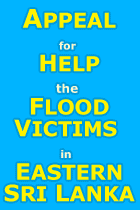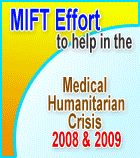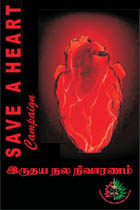 |
-- Related Information -- |
 |
|---|
|
|
 |
 |
The Tsunami disaster had a great impact on most people living in the affected area and it brought awareness and concern of people living outside. There was intense grief in the loss of human life and property. This aspect reflected on many of us living in Canada.
Many wanted to help in many ways, a group of medical doctors decided that they should leave to Sri Lanka immediately. This idea could not materialize without the family support individuals had at that time, as there were several unknown elements and fears. The individuals who decided were all part of Medical Institute for Tamils. This effort was supported by the MIFT organization, which helped in making this project satisfying and successful, even though it was heart-rending.
The team consisted of Dr. Victor Figurado (President MIFT), Dr. Rajes Logan, Dr. Sriharan Sinnadurai, Dr. Rajwani Grawal, Dr. Devi Kanapathipillai, Sharmini Kirupananthan, Prema Elagupillai, Gajen Rajendra, and was co-ordinated by Dr. Jegapathy Rajendra.
The team had 48 hours to plan, collect and proceed to Sri Lanka. They were able to accomplish this with great support from the medical and dental community, major pharmaceutical industries, pharmacies, various organizations and agencies and individuals. The team left for Sri Lanka on December 30th 2004.
Once reaching Colombo, the team decided to proceed to Batticaloa district from the information gathered from various sources. Following purchases of medications and surgical supplies the team left to Batticaloa on January 2nd 2005. On reaching Batticaloa that afternoon the team divided itself into groups and functioned efficiently to establish the base camp. That evening they conducted meetings with further fact-finding and the needs of this crisis.
The teams decided to provide medical care to refugees in the camps. The team worked in the Batticaloa district from Vallaichenai to Kalluvanchikudi. The team wanted to proceed further south from Kalluvanchikudi towards Kalmunai and Akaraipattu, but unfortunately they were not able to do so due to floods and roads were impassable. There was great demand for medical services in all refugee camps; it was difficult to decide which camp to provide the services. This was one of the first teams to land in ground zero, and it did not have much information to where to provide the service, and local organizations were also overwhelmed by the demands at that time.
The team left the base after breakfast to the refugee camps; the travel was very difficult due to the road condition following the floods. At times it took about two hours to travel to the camps. In the Batticaloa district there were nearly 80-90 camps, and each camp had roughly 800-1000 refugees. On a daily basis we were able to provide services for about 300-400 individuals. There was a great demand for supportive counselling unfortunately we did not have the man power to do so. We treated mostly infections of upper respiratory tract, gastro-intestinal, and skin. Clients with musculo-skeletal pain and early presentation of post traumatic stress disorder, anxiety and depression.
The team met with various organizations in Batticaloa so as to obtain information to further plan medical dental aid to the effected community. The team had formal discussion with the administration and the medical association of Batticaloa district hospital. This we feel would help us to link with the community needs of the district.
The team worked very efficiently and in a cooperative manner to provide the best with in their means. It was a meaningful project in the most needed time for the Tamil community who were affected by the great disaster. We thank everyone who helped us in many ways to ensure this project to take place.
Dr. J. Rajendra
Mission coordinator/Trustee
Medical Institute for Tamils - Canada
































